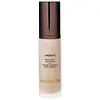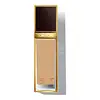Hourglass Cosmetics Ambient Soft Glow Foundation Versus Tom Ford Shade and Illuminate Soft Radiance Foundation SPF 50
What's inside
What's inside
 Key Ingredients
Key Ingredients

 Benefits
Benefits

 Concerns
Concerns

 Ingredients Side-by-side
Ingredients Side-by-side

Water
Skin ConditioningCyclopentasiloxane
EmollientCyclohexasiloxane
EmollientIsododecane
EmollientTrimethylsiloxysilicate
EmollientGlycerin
HumectantButylene Glycol
HumectantDimethicone
EmollientLauryl PEG-10 Tris(Trimethylsiloxy)Silylethyl Dimethicone
EmulsifyingPolymethylsilsesquioxane
1,2-Hexanediol
Skin ConditioningDisteardimonium Hectorite
StabilisingAcrylates/Polytrimethylsiloxymethacrylate Copolymer
Skin ConditioningMagnesium Sulfate
Sorbitan Sesquioleate
EmulsifyingDimethicone/Vinyl Dimethicone Crosspolymer
Skin ConditioningTriethoxycaprylylsilane
Dimethicone/PEG-10/15 Crosspolymer
Aluminum Hydroxide
EmollientTribehenin
EmollientCaprylyl Glycol
EmollientTocopheryl Acetate
AntioxidantEthylhexylglycerin
Skin ConditioningXanthan Gum
EmulsifyingCaesalpinia Spinosa Fruit Extract
Skin ProtectingDipropylene Glycol
HumectantSodium Citrate
BufferingKappaphycus Alvarezii Extract
Skin ConditioningTocopherol
AntioxidantCamellia Sinensis Leaf Extract
AntimicrobialCI 77891
Cosmetic ColorantIron Oxides
Water, Cyclopentasiloxane, Cyclohexasiloxane, Isododecane, Trimethylsiloxysilicate, Glycerin, Butylene Glycol, Dimethicone, Lauryl PEG-10 Tris(Trimethylsiloxy)Silylethyl Dimethicone, Polymethylsilsesquioxane, 1,2-Hexanediol, Disteardimonium Hectorite, Acrylates/Polytrimethylsiloxymethacrylate Copolymer, Magnesium Sulfate, Sorbitan Sesquioleate, Dimethicone/Vinyl Dimethicone Crosspolymer, Triethoxycaprylylsilane, Dimethicone/PEG-10/15 Crosspolymer, Aluminum Hydroxide, Tribehenin, Caprylyl Glycol, Tocopheryl Acetate, Ethylhexylglycerin, Xanthan Gum, Caesalpinia Spinosa Fruit Extract, Dipropylene Glycol, Sodium Citrate, Kappaphycus Alvarezii Extract, Tocopherol, Camellia Sinensis Leaf Extract, CI 77891, Iron Oxides
Phenylbenzimidazole Sulfonic Acid 2.7%
UV AbsorberEthylhexyl Methoxycinnamate 6.7%
UV AbsorberEthylhexyl Salicylate 4.5%
UV AbsorberZinc Oxide 3.8%
Cosmetic ColorantWater
Skin ConditioningDimethicone
EmollientPhenyl Trimethicone
Skin ConditioningButylene Glycol
HumectantGlycerin
HumectantPolymethylsilsesquioxane
Lauryl PEG-9 Polydimethylsiloxyethyl Dimethicone
Skin ConditioningHdi/PPG/Polycaprolactone Crosspolymer
Trimethylsiloxysilicate/Dimethiconol Crosspolymer
Tromethamine
BufferingPolysilicone-11
Hexyl Laurate
EmollientCetyl PEG/PPG-10/1 Dimethicone
EmulsifyingNeopentyl Glycol Diheptanoate
EmollientHydroxyethyl Urea
HumectantTremella Fuciformis Sporocarp Extract
AntioxidantHylocereus Undatus Fruit Extract
Skin ConditioningEuterpe Oleracea Fruit Oil
Skin ConditioningCarapa Guaianensis Seed Oil
Skin ConditioningLavandula Angustifolia Oil
MaskingSapindus Mukorossi Fruit Extract
Skin ConditioningMorinda Citrifolia Fruit Extract
Skin ConditioningPolyglyceryl-4 Isostearate
EmulsifyingCopaifera Officinalis Resin
MaskingTriolein
Skin ConditioningCaprylic/Capric Triglyceride
MaskingBetaine
HumectantCaffeine
Skin ConditioningAcetyl Hexapeptide-8
HumectantTocopheryl Acetate
AntioxidantTrehalose
HumectantHydrogenated Coco-Glycerides
EmollientCaesalpinia Spinosa Gum
Skin ConditioningTrimethylsiloxysilicate
EmollientPolyhydroxystearic Acid
EmulsifyingLecithin
EmollientGlyceryl Stearate
EmollientTriethoxycaprylylsilane
Laureth-7
EmulsifyingSodium Chloride
MaskingDisteardimonium Hectorite
StabilisingMethicone
EmollientLinoleic Acid
CleansingPhospholipids
Skin ConditioningStearyl Alcohol
EmollientCetearyl Alcohol
EmollientAmmonium Polyacryloyldimethyl Taurate
Emulsion StabilisingSodium Hyaluronate
HumectantTocopherol
AntioxidantTriethyl Citrate
MaskingPalmitic Acid
EmollientPhytosteryl Canola Glycerides
Skin ConditioningStearic Acid
CleansingOleic Acid
EmollientPolysorbate 80
EmulsifyingPolysorbate 20
EmulsifyingBehenyl Alcohol
EmollientSilica
AbrasiveLinalool
PerfumingDisodium EDTA
BHT
AntioxidantPotassium Sorbate
PreservativeSodium Dehydroacetate
PreservativePhenoxyethanol
PreservativeMica
Cosmetic ColorantCI 77891
Cosmetic ColorantCI 77491
Cosmetic ColorantCI 77492
Cosmetic ColorantCI 77499
Cosmetic ColorantPhenylbenzimidazole Sulfonic Acid 2.7%, Ethylhexyl Methoxycinnamate 6.7%, Ethylhexyl Salicylate 4.5%, Zinc Oxide 3.8%, Water, Dimethicone, Phenyl Trimethicone, Butylene Glycol, Glycerin, Polymethylsilsesquioxane, Lauryl PEG-9 Polydimethylsiloxyethyl Dimethicone, Hdi/PPG/Polycaprolactone Crosspolymer, Trimethylsiloxysilicate/Dimethiconol Crosspolymer, Tromethamine, Polysilicone-11, Hexyl Laurate, Cetyl PEG/PPG-10/1 Dimethicone, Neopentyl Glycol Diheptanoate, Hydroxyethyl Urea, Tremella Fuciformis Sporocarp Extract, Hylocereus Undatus Fruit Extract, Euterpe Oleracea Fruit Oil, Carapa Guaianensis Seed Oil, Lavandula Angustifolia Oil, Sapindus Mukorossi Fruit Extract, Morinda Citrifolia Fruit Extract, Polyglyceryl-4 Isostearate, Copaifera Officinalis Resin, Triolein, Caprylic/Capric Triglyceride, Betaine, Caffeine, Acetyl Hexapeptide-8, Tocopheryl Acetate, Trehalose, Hydrogenated Coco-Glycerides, Caesalpinia Spinosa Gum, Trimethylsiloxysilicate, Polyhydroxystearic Acid, Lecithin, Glyceryl Stearate, Triethoxycaprylylsilane, Laureth-7, Sodium Chloride, Disteardimonium Hectorite, Methicone, Linoleic Acid, Phospholipids, Stearyl Alcohol, Cetearyl Alcohol, Ammonium Polyacryloyldimethyl Taurate, Sodium Hyaluronate, Tocopherol, Triethyl Citrate, Palmitic Acid, Phytosteryl Canola Glycerides, Stearic Acid, Oleic Acid, Polysorbate 80, Polysorbate 20, Behenyl Alcohol, Silica, Linalool, Disodium EDTA, BHT, Potassium Sorbate, Sodium Dehydroacetate, Phenoxyethanol, Mica, CI 77891, CI 77491, CI 77492, CI 77499
 Reviews
Reviews

Ingredients Explained
These ingredients are found in both products.
Ingredients higher up in an ingredient list are typically present in a larger amount.
Butylene Glycol (or BG) is used within cosmetic products for a few different reasons:
Overall, Butylene Glycol is a safe and well-rounded ingredient that works well with other ingredients.
Though this ingredient works well with most skin types, some people with sensitive skin may experience a reaction such as allergic rashes, closed comedones, or itchiness.
Learn more about Butylene GlycolCi 77891 is a white pigment from Titanium dioxide. It is naturally found in minerals such as rutile and ilmenite.
It's main function is to add a white color to cosmetics. It can also be mixed with other colors to create different shades.
Ci 77891 is commonly found in sunscreens due to its ability to block UV rays.
Learn more about CI 77891Dimethicone is a type of synthetic silicone created from natural materials such as quartz.
What it does:
Dimethicone comes in different viscosities:
Depending on the viscosity, dimethicone has different properties.
Ingredients lists don't always show which type is used, so we recommend reaching out to the brand if you have questions about the viscosity.
This ingredient is unlikely to cause irritation because it does not get absorbed into skin. However, people with silicone allergies should be careful about using this ingredient.
Note: Dimethicone may contribute to pilling. This is because it is not oil or water soluble, so pilling may occur when layered with products. When mixed with heavy oils in a formula, the outcome is also quite greasy.
Learn more about DimethiconeDisteardimonium Hectorite comes from the clay mineral named hectorite. It is used to add thickness to a product.
It can also help stabilize a product by helping to disperse other ingredients.
Hectorite is a rare, white clay mineral.
Learn more about Disteardimonium HectoriteGlycerin is already naturally found in your skin. It helps moisturize and protect your skin.
A study from 2016 found glycerin to be more effective as a humectant than AHAs and hyaluronic acid.
As a humectant, it helps the skin stay hydrated by pulling moisture to your skin. The low molecular weight of glycerin allows it to pull moisture into the deeper layers of your skin.
Hydrated skin improves your skin barrier; Your skin barrier helps protect against irritants and bacteria.
Glycerin has also been found to have antimicrobial and antiviral properties. Due to these properties, glycerin is often used in wound and burn treatments.
In cosmetics, glycerin is usually derived from plants such as soybean or palm. However, it can also be sourced from animals, such as tallow or animal fat.
This ingredient is organic, colorless, odorless, and non-toxic.
Glycerin is the name for this ingredient in American English. British English uses Glycerol/Glycerine.
Learn more about GlycerinPolymethylsilsesquioxane is a silicone used as a film forming agent.
When applied to the skin, this ingredient creates an invisible film on the surface. This film still allows oxygen to pass through, but prevents moisture from escaping. This can help condition and hydrate the skin. It also leaves a silky feel when applied.
Polymethylsilsesquioxane has not been shown to clog pores. It has been deemed safe to use up to 55%, but most cosmetics use much less.
If you have concerns about using this ingredient, we recommend speaking with a professional.
Learn more about PolymethylsilsesquioxaneTocopherol (also known as Vitamin E) is a common antioxidant used to help protect the skin from free-radicals and strengthen the skin barrier. It's also fat soluble - this means our skin is great at absorbing it.
Vitamin E also helps keep your natural skin lipids healthy. Your lipid skin barrier naturally consists of lipids, ceramides, and fatty acids. Vitamin E offers extra protection for your skin’s lipid barrier, keeping your skin healthy and nourished.
Another benefit is a bit of UV protection. Vitamin E helps reduce the damage caused by UVB rays. (It should not replace your sunscreen). Combining it with Vitamin C can decrease sunburned cells and hyperpigmentation after UV exposure.
You might have noticed Vitamin E + C often paired together. This is because it is great at stabilizing Vitamin C. Using the two together helps increase the effectiveness of both ingredients.
There are often claims that Vitamin E can reduce/prevent scarring, but these claims haven't been confirmed by scientific research.
Learn more about TocopherolTocopheryl Acetate is AKA Vitamin E. It is an antioxidant and protects your skin from free radicals. Free radicals damage the skin by breaking down collagen.
One study found using Tocopheryl Acetate with Vitamin C decreased the number of sunburned cells.
Tocopheryl Acetate is commonly found in both skincare and dietary supplements.
Learn more about Tocopheryl AcetateTriethoxycaprylylsilane is a silicone used to bind and stabilize ingredients.
As an emulsifier, it helps prevent ingredients from separating. This can help elongate the shelf life of products.
Triethoxycaprylylsilane is often used to coat mineral sunscreens ingredients to help give a better feel. It also helps reduce oxidative stress in sunscreens.
Learn more about TriethoxycaprylylsilaneThis silicone is an emollient. Emollients create a thin film on the skin to prevent moisture from escaping.
It is not soluble in water and helps increase water-resistance in products.
According to a manufacturer, it can blend seamlessly with silicone oils, such as Cyclopentasiloxane.
Learn more about TrimethylsiloxysilicateWater. It's the most common cosmetic ingredient of all. You'll usually see it at the top of ingredient lists, meaning that it makes up the largest part of the product.
So why is it so popular? Water most often acts as a solvent - this means that it helps dissolve other ingredients into the formulation.
You'll also recognize water as that liquid we all need to stay alive. If you see this, drink a glass of water. Stay hydrated!
Learn more about Water